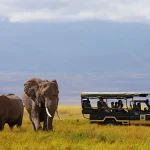The migration of vast numbers of wildebeest, accompanied by large numbers of zebra and smaller numbers of Thomson’s gazelle, eland, and impala, is an annual event in Serengeti. They constantly move throughout the year in search of fresh grazing. The exact timing of the Serengeti wildebeest migration depends on rainfall patterns each year and can be unpredictable. Serengeti Migration Safari stay at Singita 2025 will be among the best African safari experiences.
Thousands of travelers fly to Tanzania Serengeti yearly to witness the thrilling Mara River migration. In contrast, many others flock to the Central Highlands of Mexico to witness the astounding annual wildlife events of millions of monarch butterflies migrating from the United States and Canada. If you want to be one of these epic travelers and witness the wildebeest safari migration in 2025, you can stay at the Singita collection and earn a considerable discount. Check out the offer here.
Migration pattern month by month;
From January to March.
The herds usually calve in the southern Serengeti plains, where grass growth is most productive and nutrient content is high.
From April-May.
The herds start moving north towards the central Serengeti plains.
During June-July.
The herds move northwest towards Singita Grumeti. Herds continue north towards the Maasai Mara and can be seen at Singita Mara River Tented Camp in Lamai.
During August-September.
The herds must cross the Mara River before they reach Kenya’s Maasai Mara. The animals then continue to move backward and forward across the Mara River as they continue into the Maasai Mara.
October-November.
Following the rainfalls, the migration continues north into the Maasai Mara.
December.
Following the December rains, the migration starts moving south again, back into the Serengeti. The herds may return to Singita Grumeti as they make their way south.








